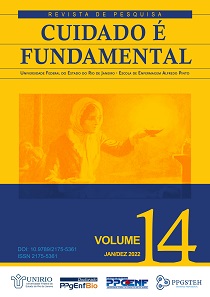Factores de riesgo para la recurrencia del intento de suicidio
DOI:
https://doi.org/10.9789/2175-5361.rpcfo.v14.11929Palabras clave:
Factores de riesgo, Reincidencia, Intento de Suicidio, SuicidioResumen
Objetivo: analizar los factores de riesgo para la recurrencia de la tentativa de suicidio en personas atendidas en la Unidad de Atención de Emergencia de Assis, SP, Brasil. Método: estudio cuantitativo, participantes que intentaron suicidarse y asistieron a la unidad de referencia. Las entrevistas individuales se realizaron entre diciembre de 2017 y noviembre de 2019. Se dividieron en personas que intentaron suicidarse por primera vez y reincidentes. Se utilizó la prueba exacta de Fisher, la prueba t-Student para dos muestras y el Análisis de Regresión Logística Múltiple.Resultados: 113 participantes, siendo 80 (70,8%) reincidentes, ya que refirieron antecedentes de intento de suicidio y 33 (20,2%) siendo la primera vez. Conclusión: El grupo de edad de 20 a 47 años, la autopercepción de experimentar relaciones familiares negativas, la existencia de trastorno mental, la existencia de enfermedades crónicas no transmisibles y las personas sin antecedentes de intento de suicidio en la familia fueron de riesgo. factores asociados a las estadísticas de ocurrencia de reincidencia en intentos de suicidio.
Descargas
Citas
World Health Organization (WHO). Live life: an implementation guide for suicide prevention in countries. [Internet]. 2021 [cited 2021 oct 1]. Available from: https://www.who.int/publications/i/item/9789240026629
World Health Organization (WHO). Suicide worldwide in 2019: global health estimates. [Internet]. 2021 [cited 2021 oct 1]. Available from: https://www.who.int/publications/i/item/9789240026643
Ministério da Saúde (BR). Boletim epidemiológico: 2021 [Internet]. Brasília: Ministério da Saúde [acesso em 1 de outubro 2021]. Disponível em: https://www.gov.br/saude/pt-br/centrais-de-conteudo/publicacoes/boletins/boletins-epidemiologicos/edicoes/2021/boletim_epidemiologico_svs_33_final.pdf
Silva DA, Marcolan JF. Suicide attempts and suicide in Brazil: An epidemiological analysis. Florence Nightingale J Nurs. 2021 [cited 2021 dez 10];29(3). Available from: https://doi.org/10.5152/FNJN.2021.21035
Marcolan JF, Silva DA. O comportamento suicida na realidade brasileira: aspectos epidemiológicos e da política de prevenção. Rev. M. 2019 [acesso em 14 de junho 2021];4(7). Disponível em: https://doi.org/10.9789/2525-3050.2019.v4i7.31-44
Vásquez-Escobar L, Benítez-Camargo S. Intento suicida: un análisis municipal de factores asociados 2012-2017. Hacia promoc. Salud. 2021 [cited 2021 dez 10];26(2). Available from: https://doi.org/10.17151/hpsal.2021.26.2.6
Silva DA, Marcolan JF. O impacto das relações familiares no comportamento suicida. Res., Soc. Dev. 2021 [acesso em 1 de outubro 2021];10(2). Disponível em: https://doi.org/10.33448/rsd-v10i2.12349
Bachmann S. Epidemiology of Suicide and the Psychiatric Perspective. Int J Environ Res Public Health. 2018 [cited 2021 oct 1];15(7). Available from: https://doi.org/10.3390/ijerph15071425
Wayland S, Coker S, Maple M. The human approach to supportive interventions: The lived experience of people who care for others who suicide attempt. Int J Ment Health Nurs. 2021 [cited 2021 oct 1];30(3). Available from: https://doi.org/10.1111/inm.12829
Irigoyen-Otiñano M, Puigdevall-Ruestes M, Mur-Laín M, González-Pinto A, Portella MJ, Baca-García E, et al. Absence of association between the level of lethality and the recidivism of suicide attempts in a Spanish province. Actas Esp Psiquiatr. 2019 [cited 2021 oct 1];47(5). Available from: https://pubmed.ncbi.nlm.nih.gov/31648340/
Witt K, Milner A, Spittal MJ, Hetrick S, Robinson J, Pirkis J, et al. Population attributable risk of factors associated with the repetition of self-harm behaviour in young people presenting to clinical services: a systematic review and meta-analysis. Eur Child Adolesc Psychiatry. 2019 [cited 2021 oct 1];28. Available from: https://doi.org/10.1007/s00787-018-1111-6
Chai Y, Luo H, Yip PSF. Prevalence and risk factors for repetition of non-fatal self-harm in Hong Kong, 2002–2016: A population-based cohort study. Lancet Reg Health West Pac. 2020 [cited 2021 oct 1];2. Available from: https://doi.org/10.1016/j.lanwpc.2020.100027
Golay P, Ostertag L, Costanza A, Van der Vaeren B, Dorogi Y, Saillant S, et al. Patients with first versus multiple episodes of self-harm: how do their profiles differ? Ann Gen Psychiatry. 2021 [cited 2021 dez 10];20. Available from: https://doi.org/10.1186/s12991-021-00351-5
Liu B-P, Lunde KB, Jia C-X, Qin P. The short-term rate of non-fatal and fatal repetition of deliberate self-harm: A systematic review and meta-analysis of longitudinal studies. J Affect Disord. 2020 [cited 2021 dez 10];273. Available from: https://doi.org/10.1016/j.jad.2020.05.072
von Elm E, Altman DG, Egger M, Pocock SJ, Gøtzsche PC, Vandenbroucke JP. The Strengthening the Reporting of Observational Studies in Epidemiology (STROBE) Statement: guidelines for reporting observational studies. Int J Surg. 2014 [cited 2021 dez 10];12(12). Available from: https://doi.org/10.1016/j.ijsu.2014.07.013
Pinheiro TP, Warmling D, Coelho EBS. Caracterização das tentativas de suicídio e automutilações por adolescentes e adultos notificadas em Santa Catarina, 2014-2018. Epidemiol. Serv. Saúde. 2021 [acesso em 10 de dezembro 2021];30(4). Disponível em: https://doi.org/10.1590/S1679-49742021000400026
Otzen T, Fuentes N, Wetzel G, Henríquez C, Antúnez Z. Suicidabilidad y apoyo social percibido en estudiantes universitarios con enfermedades crónicas no transmisibles. Ter. psicol. (En línea). 2020 [cited 2021 dez 10];38(1). Available from: https://dx.doi.org/10.4067/S0718-48082020000100119
Tang S, Ports KA, Stone DM, Lin HC. The mediating role of internalizing and externalizing symptoms in the association between child neglect and suicide attempt in adulthood. Int J Contr Saf Promot. 2021 [cited 2021 dez 10];29. Available from: https://doi.org/10.1080/17457300.2021.2007406
McClellan C, Ali MM, Mutter R. Impact of Mental Health Treatment on Suicide Attempts. J Behav Health Serv Res. 2021 [cited 2021 dez 10];48(1). Available from: https://doi.org/10.1007/s11414-020-09714-4
Uğur K, Polat H. The relationship of suicidal ideation with psychological pain and anger rumination in patients with major depressive disorder. Arch Psychiatr Nurs. 2021 [cited 2021 dez 10];35(5). Available from: https://doi.org/10.1016/j.apnu.2021.06.012
Rogers ML, Joiner TE, Shahar G. Suicidality in Chronic Illness: An Overview of Cognitive–Affective and Interpersonal Factors. J Clin Psychol Med Settings. 2021 [cited 2021 dez 10];28(1). Available from: https://doi.org/10.1007/s10880-020-09749-x
Huh Y, Kim SM, Lee JH, Nam GE. Associations between the type and number of chronic diseases and suicidal thoughts among Korean adults. Psychiatry Res. 2021 [cited 2021 dez 10];296. Available from: https://doi.org/10.1016/j.psychres.2020.11
Onyeka IN, Maguire A, Ross E, O'Reilly D. Does physical ill-health increase the risk of suicide? A census-based follow-up study of over 1 million people. Epidemiol Psychiatr Sci. 2020 [cited 2021 dez 10];29. Available from: https://doi.org/10.1017/S2045796020000529
Ahmedani BK, Peterson EL, Hu Y, Rossom RC, Lynch F, Lu CY, et al. Major Physical Health Conditions and Risk of Suicide. Am J Prev Med. 2017 [cited 2021 dez 10];53(3). Available from: https://doi.org/10.1016/j.amepre.2017.04.001
Conti C, Mennitto C, Di Francesco G, Fraticelli F, Vitacolonna E, Fulcheri M. Clinical Characteristics of Diabetes Mellitus and Suicide Risk. Front Psychiatry. 2017 [cited 2021 dez 10];8. Available from: https://doi.org/10.3389/fpsyt.2017.00040
Rihmer Z, Gonda X, Torzsa P, Kalabay L, Akiskal HS, Eory A. Affective temperament, history of suicide attempt and family history of suicide in general practice patients. J Affect Disord. 2013 [cited 2021 dez 10];149(1-3). Available from: https://doi.org/10.1016/j.jad.2013.02.010
Fornaro M, Grunebaum MF, Burke AK, Mann JJ, Oquendo MA. Comparison of familial and non-familial suicidal behaviors among people with major depressive disorder: Testing the discriminative predicting role of high-yield clinical variables. J Psychiatr Res. 2018 [cited 2021 dez 10];102. Available from: https://doi.org/10.1016/j.jpsychires.2018.02.021
Muniz JPC, Finger BK, Davi WS, Araújo KSS, Côrtes MA. Mental vulnerability and suicide by contagion during the academic experience. Rev Med (São Paulo). 2021 [acesso em 12 de dezembro 2021];100(4). Disponível em: http://dx.doi.org/10.11606/issn.1679-9836.v100i4p351-357
Spillane A, Matvienko-Sikar K, Larkin C, Arensman E. How do people experience a family member’s high-risk self-harm? An interpretative phenomenological analysis. Arch Suicide Res. 2020 [cited 2021 dez 10];24(sup1). Available from: https://doi.org/10.1080/13811118.2019.1574248
Rezaie L, Schwebel DC. Psychological needs of the families of patients who attempted suicide by self-immolation: An overlooked issue. Burns. 2019 [cited 2021 dez 10];45(8). Available from: https://doi.org/10.1016/j.burns.2019.08.013
Publicado
Versiones
- 2022-11-29 (2)
- 2022-11-28 (1)
Cómo citar
Número
Sección
Licencia
Derechos de autor 2022 Revista de Pesquisa Cuidado é Fundamental Online

Esta obra está bajo una licencia internacional Creative Commons Atribución-NoComercial-SinDerivadas 4.0.
TERMO DE TRANSFERÊNCIA DE DIREITOS AUTORAIS
Transfiro os direitos autorais deste artigo para a Revista de Pesquisa Cuidado é Fundamental - Online - RPCF, assim que ele for aceito para a devida publicação eletrônica. Os direitos de autor incluem o direito de reproduzir na íntegra ou em parte por qualquer meio, distribuir o referido artigo, incluindo figuras, fotografias, bem como as eventuais traduções. O autor pode ainda, imprimir e distribuir cópias do seu artigo, desde que mencione que os direitos pertencem a RPCF. Declaro que este manuscrito é original, não tendo sido submetido à publicação, na íntegra ou em partes para outros periódicos online ou não, assim cmmo em Anais de eventos científicos ou capítulos de livros.






























